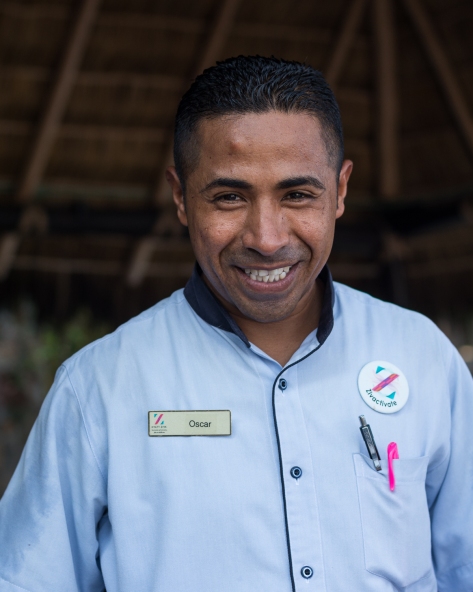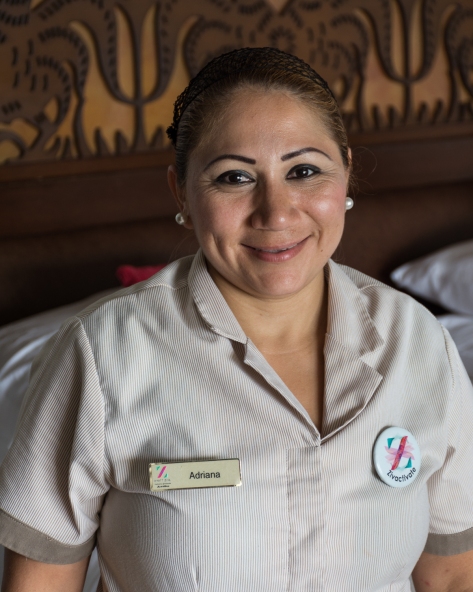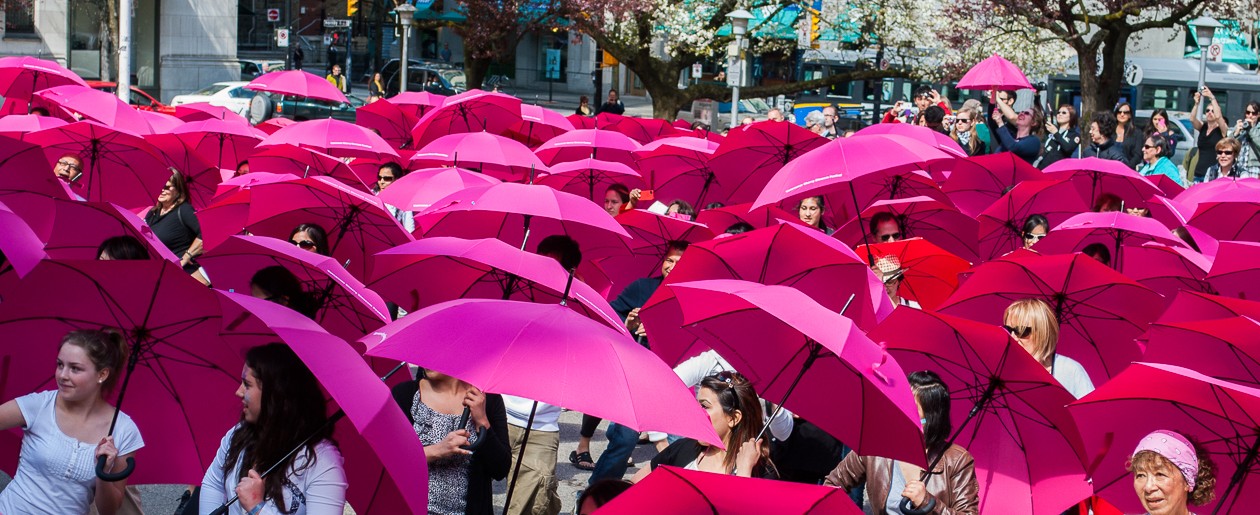The brief:
Your first assignment is to make five portraits of five different people from your local area who were previously unknown to you.
Due to work constraints and other personal issues happening in my life during the past few weeks, I decided to do this assignment while I was on holiday, where hopefully I would have more clarity of thought. While vacationing in Puerto Vallarta, Mexico, I decided to photograph the hotel staff that I met for this project. The photographs were only taken after having some interesting dialogue with each of the subjects. All photos were taken in situ where the subjects worked. With the exception of the room attendant (fig 5), all photos were taken in one of the many restaurants on the premises. The room attendant’s photo was taken in the hotel room. Those of the servers and restaurant manager were taken at the end of the meal and I remained seated in my seat to take the photo as I wanted to convey their attendant stature. I gave no instructions other than to indicate where they should stand on the opposite side of the table. I allowed the subjects to pose themselves and their facial expressions. As they were all busy working, I had to work quickly and only managed to fire off about three shots for each subject.
What I really like about this set of images is the pride that is evident on all the subjects’ faces, as well as the pleasure of being asked for their portrait. This series is all about recognition. How often do the restaurant staff and room attendants just meld into the background of one’s experiences unnoticed when one is out enjoying oneself? Berger (2013: 140) states that “between people there is no such thing as unilateral one-way knowledge.” An exchange is always required, be it either verbal or for instance in a foreign country by means of various gestures in order to make oneself understood. Each person that I have photographed here is a unique individual. Sure they are identified by their uniforms and badges (signs), but these are all man-made items and don’t serve to reflect their personalities. They only aid to tell us ‘what’ they are, but not ‘who’. In conversations with some of these people it appears that they are not highly paid at all – approximately 80 pesos per day (just a little over CAD $5 per day) so providing excellent service for tips is a huge part of their daily routine.
The close-up is the opposite of a statistic. … What first matters is recognition. Recognition. The word appears to make no claim and to sound poor. Yet that perhaps is how it should be.
(Berger, 2013: 142)
The clothing, gestures, and facial expressions all contribute to the semiological system of reading the photograph. There is a coherence of appearances in the series below. As Berger (2013: 71) states:
Appearances also cohere within the mind as perceptions. … To recognize an appearance requires the memory of other appearances. And these memories, often projected as expectations, continue to qualify the seen long after the stage of primary recognition. … One image interpentrates another.





ASSESSMENT CRITERIA
Demonstration of technical and visual skills (materials, techniques, observational skills, visual awareness, design and compositional skills)
I used my Nikon D7200, together with a 50 mm f1.8 lens so that I could blur the backgrounds. My primary focus was on the eye closest to me and I am happy that all the eyes are nice and sharp. I had to use my camera’s pop up flash on a few occasions and this enhanced the specular highlights on the faces of the subjects in fig. 1 and 4 who were sweating due to the heat. The choice for background was rather limited in the indoor restaurants while the outdoor restaurants provided a more interesting background in terms of thatch texture and vegetation. Also the headboard of the bed in fig 5 was quite spectacular so I was extremely pleased to include that as the background. The only issue I had with fig 5, and unfortunately I only noticed this when uploading the photos after returning home, was the hint of red cushion behind the subject on the bed. I tried to remove it in Photoshop but I am very rusty with Photoshop so decided rather to leave it in than make a mess. I need to upgrade my PS skills.
Quality of Outcome (content, application of knowledge, presentation of work in a coherent manner, discernment, conceptualisation of thoughts, communication of ideas)
My work was largely influenced by August Sander from exercise 1.2, Hans Eijkelboom and Paul Matzner. I am fairly happy with the outcome of the photographs which I shot under very difficulty circumstances, as my mother had passed away while I was on holiday. Sontag in her essay “Photographic Evangels” writes that ‘every portrait of another person is a “self-portrait” of the photographer’ (1977: 122). Each portrait that I made was a stepping stone to celebrating my mother’s life, and in a way each portrait was serving as my mask in hiding my sorrow.
Demonstration of Creativity (imagination, experimentation, invention, development of a personal voice)
By choosing to do headshots I might have limited my creativity a bit. However, I felt that headshots would best allow for an element of ambiguity that I wanted to introduce to the portraits in that their occupations are not immediately evident until one reads the caption. My 50mm lens allowed for some interesting blurred backgrounds.
Context (reflection, research, critical thinking)
I am finding that portraiture is quite a difficult topic, more so than I initially envisioned. In particular the semiology of reading faces is quite daunting. It is perhaps more akin to analysing a close-up than a wide-angle photograph. One has to be more in tuned to very subtle nuances.
In preparation for my assignment I looked at the following photographers (my details remarks can be found on their pages):
- Juergen Teller – I particularly liked the semiology of framing his subjects in that no-man’s land on a doorstep, highlighting their transition between their ordinary life and professional life; their youth and innocence about to be discarded on the pavement outside the studio.
- Paul Matzner – the typology of people on certain streets in various US cities. Paul Matzner also stopped by my review and left a comment.
- Hans Eijkelboom – the typologies of fashion found on various locations around the world revealing a social anthropology and society’s reliance on consumerism – the identity of fitting in.
I have also decided to study one of the visual culture textbooks on the side, with the hope that this will help improve my critical analysis. As I go along I will make brief notes on my exploration. Thus far I have covered:
I was really lucky to attend quite a few exhibitions. The annual Capture Photography festival brought quite a few unknown photographers to my attention. My detailed notes are on the relevant exhibition pages linked below:
- Fugazi – Evan Lee
- Brian Howell: A Survey
- Erin O’Keefe at Gallery Jones
- Sandokai: Grasping at things is surely delusion by Josema Zamorano
- Karen Zalamea | Spectres of Desire
- análekta: The floweriness, The bareness – Merle Addison
- Scream the Exhibition
- Chris Shepherd: Constructs. Chris Shepherd happened across my write up and was kind enough to leave a comment on my blog.
- Mirrored Explosions | Sanaz Mazinani
- Nanitch: Early Photographs of British Columbia from the Langmann Collection
- Mashup – The Birth of Modern Culture. Also as an accompaniment to the exhibition was this online lecture on Mashup Curators’ Salon where various curators explained more of the work on display in depth.
Reference List
Berger, John (2013) Understanding a Photograph. New York: Aperture.
Sontag, Susan (1977) On Photography. New York: Picador.
Bibliography
Angier, R. (2015) Train Your Gaze: A Practical and Theoretical Introduction to Portrait Photography (2nd edition). London: Bloomsbury.
Kozloff, M. (2007) The Theatre of the Face: Portrait Photography since 1900. London: Phaidon Press


Good post, Lynda. You are away ahead of me at present, and I’m amazed at your fortitude considering recent events in your life. Am looking forward to following up those refs you provide, as I am back at my desk now after a few weeks off.
LikeLike
Thanks Holly, you have no idea how long I was dragging my heels on this one.
LikeLike
A very well-grounded assignment in terms of all the reading and thinking. It makes a lot of sense but I really hadn’t thought so much before about the ‘recognition’ aspect. That’s a really good way of approaching portraiture I think, especially when approaching strangers.
LikeLike
Thanks Catherine.
LikeLike
Well done , I especially like the second portrait.
LikeLike
Thanks Judy. I think I agree with you. That’s my favourite too. He was such a character as well.
LikeLike